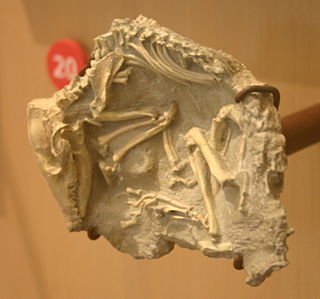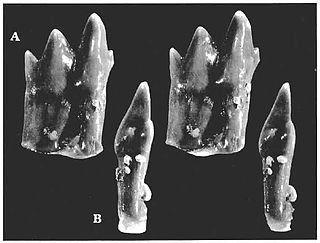
Eutheria is the clade consisting of all therian mammals that are more closely related to placentals than to marsupials.

Didelphodon is a genus of stagodont metatherians from the Late Cretaceous of North America.

Tribosphenida is a group (infralegion) of mammals that includes the ancestor of Hypomylos, Aegialodontia and Theria. Its current definition is more or less synonymous with Boreosphenida.

Therizinosaurs were large herbivorous theropod dinosaurs whose fossils have been found across the Early to Late Cretaceous deposits in Asia and North America. Various features of the forelimbs, skull and pelvis unite these finds as both theropods and maniraptorans, close relatives to birds. The name of the representative genus, Therizinosaurus, is derived from the Greek θερίζω and σαῦρος. The older representative, Segnosaurus, is derived from the Latin sēgnis ('slow') and the Greek σαῦρος.

Echinodon is a genus of heterodontosaurid dinosaur that lived during the earliest Cretaceous of southern England and possibly western France in the Berriasian epoch. The first specimens were jaw bones named Echinodon becklesii by Sir Richard Owen in 1861, and since their original description only additional teeth have been discovered. The specific name honours collector Samuel Beckles who discovered the material of Echinodon and many other taxa from across England, while the genus name translates as "prickly tooth" in reference to the dental anatomy of the taxon.

The Australosphenida are a clade of mammals, containing mammals with tribosphenic molars, known from the Jurassic to Mid-Cretaceous of Gondwana. They are thought to have acquired their tribosphenic molars independently from those of Tribosphenida. Fossils of australosphenidans have been found from the Jurassic of Madagascar and Argentina, and Cretaceous of Australia and Argentina. Monotremes have also been considered a part of this group in some studies, but this is disputed.

Volaticotherini is a clade of eutriconodont mammals from the Mesozoic. In addition to the type genus Volaticotherium, it includes the genera Argentoconodon, Ichthyoconodon, and potentially Triconolestes.
Ausktribosphenidae is an extinct family of australosphenidan mammals from the Early Cretaceous of Australia and mid Cretaceous of South America.

Paracryptodira is an extinct group of reptiles in the clade Testudinata, known from the Jurassic to Paleogene of North America and Europe. Initially treated as a suborder sister to Cryptodira, they were then thought to be a very primitive lineage inside the Cryptodira according to the most common use of the latter taxon. They are now often regarded as late-diverging stem-turtles, lying outside the clade formed by Cryptodira and Pleurodira. The paracryptodires are said to have phylogenic relationships, noted as primary subclades, within the Baenidae and Pleurosternidae. Within each subclade, lies many biodiverse turtles that are continuously being investigated and added to the fossil record. Paracryptodires are divided into three main groups, Compsemydidae, known from the Late Jurassic to Paleocene of North America and Europe, Pleurosternidae, known from the Late Jurassic to Early Cretaceous of North America and Europe, and Baenidae, known from the Early Cretaceous to Eocene of North America. The latter two groups are more closely related to each other than to Compsemys, forming the clade Baenoidea.
Deltatheroida is an extinct group of basal metatherians that were distantly related to modern marsupials. The majority of known members of the group lived in the Cretaceous; one species, Gurbanodelta kara, is known from the late Paleocene (Gashatan) of China. Their fossils are restricted to Central Asia and North America. This order can be defined as all metatherians closer to Deltatheridium than to Marsupialia.
Shuotherium is a fossil mammal known from Middle-Late Jurassic of the Forest Marble Formation of England, and the Shaximiao Formation of Sichuan, China.

Ambondro mahabo is a mammal from the Middle Jurassic (Bathonian) Isalo III Formation of Madagascar. The only described species of the genus Ambondro, it is known from a fragmentary lower jaw with three teeth, interpreted as the last premolar and the first two molars. The premolar consists of a central cusp with one or two smaller cusps and a cingulum (shelf) on the inner, or lingual, side of the tooth. The molars also have such a lingual cingulum. They consist of two groups of cusps: a trigonid of three cusps at the front and a talonid with a main cusp, a smaller cusp, and a crest at the back. Features of the talonid suggest that Ambondro had tribosphenic molars, the basic arrangement of molar features also present in marsupial and placental mammals. It is the oldest known mammal with putatively tribosphenic teeth; at the time of its discovery it antedated the second oldest example by about 25 million years.
The Jobu Formation is a Cretaceous geologic formation of Late Cenomanian age. Dinosaur remains are among the fossils that have been recovered from the formation, although none have yet been referred to a specific genus. The oldest confirmed tyrannosaurid premaxillary tooth was recovered from the Jobu Formation. The mammal Sorlestes is also known from the formation.

Yinotheria is a proposed basal subclass clade of crown mammals uniting the Shuotheriidae, an extinct group of mammals from the Jurassic of Eurasia, with Australosphenida, a group of mammals known from the Jurassic to Cretaceous of Gondwana, which possibly include living monotremes. Today, there are only five surviving species of monotremes which live in Australia and New Guinea, consisting of the platypus and four species of echidna. Fossils of yinotheres have been found in England, China, Russia, Madagascar and Argentina. Contrary to other known crown mammals, they retained postdentary bones as shown by the presence of a postdentary trough. The extant members (monotremes) developed the mammalian middle ear independently.

Pappotherium is an extinct genus of mammals from the Albian of Texas, US, known from a fossilized maxilla fragment bearing two tribosphenic molars, discovered within the Glen Rose Formation near Decatur, Wise County, Texas.

Dyskritodon is a genus of extinct mammal from the Early Cretaceous of Morocco, and possibly the Early Jurassic of India. Of uncertain affinities, it is tentatively described as a eutriconodont.

Triconodon is a genus of extinct mammal from the Early Cretaceous of England and France with two known species: T. mordax and T. averianovi. First described in 1859 by Richard Owen, it is the type genus for the order Triconodonta, a group of mammals characterised by their three-cusped (triconodont) molar teeth. Since then, this "simplistic" type of dentition has been understood to be either ancestral for mammals or else to have evolved multiple times, rendering "triconodonts" a paraphyletic or polyphyletic assemblage respectively, but several lineages of "triconodont" mammals do form a natural, monophyletic group, known as Eutriconodonta, of which Triconodon is indeed part of.
Spalacotherium is a genus of extinct mammal from the Early Cretaceous of Europe. The type species Spalacotherium tricuspidens was originally named by Richard Owen in 1854, and its material includes maxillary and dentary fragments and many teeth from the Berriasian Lulworth Formation of southern England. Referred species include S. taylori, S. evansae and S. hookeri also from the Lulworth deposits, and S. henkeli from Barremian deposits of Galve, Spain. The Lulworth taxon Peralestes longirostris, named by Owen in 1871, is a junior synonym of the type species S. tricuspidens. Spalacotherium is the namesake taxon of the family Spalacotheriidae, which is an extinct clade within Trechnotheria that may be closely related to the Gondwanan clade Meridiolestida, or united with the family Zhangheotheriidae to form Symmetrodonta.S. evansae is also from the Berriasian aged Angeac-Charente bonebed in western France.
Pseudosaurillus is a genus of extinct lizard from the Early Cretaceous of southern England. The type and only species is Pseudosaurillus becklesi, named in 1967 by R. Hoffstetter limited jaw and tooth material from the Berriasian Lulworth Formation. A large amount of material that was additionally referred to Saurillus by Hoffstetter was reassigned to Pseudosaurillus in 1983 by Estes, but this has since been reclassified within its own genus Parasaurillus by Susan E. Evans and Belinda Searle in 2002. The taxon was found in the Mammal Bed near the base of the formation alongside the other lizards Becklesius, Dorsetisaurus, Durotrigia, Paramacellodus, Parasaurillus, Parviraptor and Saurillus. Like Becklesius, Pseudosaurillus may be a member of the family Paramacellodidae.
Ninjatitan is a genus of titanosaur sauropod dinosaur from the Early Cretaceous (Berriasian-Valanginian)-aged Bajada Colorada Formation of Argentina. It is the oldest titanosaur known to date and the type species N. zapatai was named and described in 2021. Its generic name comes from a nickname of Argentine palaeontologist Sebastian Apesteguia, and the specific name comes from technician Rogelio Zapata. It is known from postcranial remains discovered in 2014.














